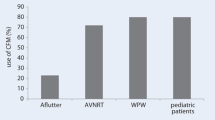Abstract
The purpose of this study was to report the feasibility and procedural technique of minimal or no fluoroscopy in the ablation of ventricular arrhythmias in the pediatric population. A retrospective review was performed of all patients <21 years old who underwent ablation of ventricular arrhythmias using three-dimensional (3D) mapping with no or minimal fluoroscopy at a single institution. Five patients underwent electrophysiology studies for ventricular tachycardia or frequent premature ventricular complexes. Three patients had right-sided arrhythmias, and two patients had left-sided arrhythmias. Electro-anatomic mapping with the 3D EnSite NavX system and radiofrequency ablation was used in all patients. No fluoroscopy was used in the patients with right-sided arrhythmias. The two patients with left-sided arrhythmias had 1.0 and 1.9 min of fluoroscopy, respectively. The mean procedure time was 168 min (range 95 to 270). There has been no recurrence at mean follow-up of >1 year. Three-dimensional mapping systems have allowed pediatric electrophysiologic procedures to be performed with minimal to no fluoroscopy in patients with challenging arrhythmias, including ventricular arrhythmias. The decrease in radiation exposure decreases the risk of long-term adverse sequelae resulting from radiation exposure, which is especially important in children.

Similar content being viewed by others
References
Clark J, Bockoven JR, Lane J, Patel CR, Smith G (2008) Use of three-dimensional catheter guidance and transesophageal echocardiography to eliminate fluoroscopy in catheter ablation of left-sided accessory pathways. Pacing Clin Electrophysiol 31(3):283–289
Drago F, Silvetti MS, Di Pino A, Grutter G, Bevilacqua M, Leibovich S (2002) Exclusion of fluoroscopy during ablation treatment of right accessory pathway in children. J Cardiovasc Electrophysiol 13(8):778–782
FDA Unveils Initiative to Reduce Unnecessary Radiation Exposure from Medical Imaging (2010) Available online at: http://www.fda.gov/newsevents/newsroom/pressannouncements/ucm200085.htm
Ferguson JD, Helms A, Mangrum JM, Mahapatra S, Mason P, Bilchick K et al (2009) Catheter ablation of atrial fibrillation without fluoroscopy using intracardiac echocardiography and electroanatomic mapping. Circ Arrhythm Electrophysiol 2(6):611–619
Helms A, West JJ, Patel A, Mounsey JP, DiMarco JP, Mangrum JM et al (2009) Real-time rotational ICE imaging of the relationship of the ablation catheter tip and the esophagus during atrial fibrillation ablation. J Cardiovasc Electrophysiol 20(2):130–137
Justino H (2006) The ALARA concept in pediatric cardiac catheterization: techniques and tactics for managing radiation dose. Pediatr Radiol 36(Suppl)2:146–153
Limacher MC, Douglas PS, Germano G, Laskey WK, Lindsay BD, McKetty MH et al (1998) ACC expert consensus document. Radiation safety in the practice of cardiology. American College of Cardiology. J Am Coll Cardiol 31(4):892–913
Nakagawa H, Beckman KJ, McClelland JH, Wang X, Arruda M, Santoro I et al (1993) Radiofrequency catheter ablation of idiopathic left ventricular tachycardia guided by a Purkinje potential. Circulation 88(6):2607–2617
Smith G, Clark JM (2007) Elimination of fluoroscopy use in a pediatric electrophysiology laboratory utilizing three-dimensional mapping. Pacing Clin Electrophysiol 30(4):510–518
Tuzcu V (2007) A nonfluoroscopic approach for electrophysiology and catheter ablation procedures using a three-dimensional navigation system. Pacing Clin Electrophysiol 30(4):519–525
Wagner LK (2006) Minimizing radiation injury and neoplastic effects during pediatric fluoroscopy: what should we know? Pediatr Radiol 36(Suppl 2):141–145
Author information
Authors and Affiliations
Corresponding author
Rights and permissions
About this article
Cite this article
Von Bergen, N.H., Bansal, S., Gingerich, J. et al. Nonfluoroscopic and Radiation-Limited Ablation of Ventricular Arrhythmias in Children and Young Adults: A Case Series. Pediatr Cardiol 32, 743–747 (2011). https://doi.org/10.1007/s00246-011-9956-1
Received:
Accepted:
Published:
Issue Date:
DOI: https://doi.org/10.1007/s00246-011-9956-1



